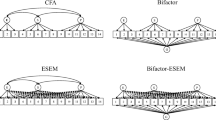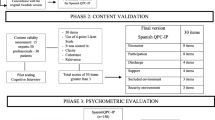Abstract
Inpatient mental health readmission rates have increased dramatically in recent years, with a subset of consumers referred to as revolving-door patients. In an effort to reduce the financial burden associated with these patients and increase treatment efficacy, researchers have begun to explore factors associated with increased service utilization. To date, predictors of increased service usage are remarkably discrepant across studies. Further exploration, therefore, is needed to better explicate the relevance of “traditional” predictors and also to identify alternate strategies that may assist in predicting rehospitalization. One method that may be helpful in identifying patients at high risk is the development of a psychometric screening procedure. As a means to this end, the present study was designed to assess the potential usefulness of psychometric data in predicting mental health service utilization. The sample consisted of 131 patients hospitalized during an index period of 8 months at an acute-care psychiatric hospital. Number of readmissions was recorded in a 9 month post-index period. Measures completed during the index admission included the Brief Psychiatric Rating Scale-Anchored (BPRS-A), Symptom Checklist-90-Revised (SCL-90-R), Kaufman Brief Intelligence Test (K-BIT), and the Beck Depression Inventory (BDI). Results indicated that psychometric data accounted for significant variance in predicting past, present and future mental health service utilization. The BPRS-A, SCL-90-R, and BDI show particular promise as time efficient psychometric screening instruments that may better enable practitioners to identify patients proactively who are at increased risk for rehospitalization. Implications are discussed with regard to patient-treatment matching and discharge planning.
Similar content being viewed by others

REFERENCES
Druss BG, Bruce ML, Jacobs SC, et al: Trends over a decade for a general hospital psychiatry unit. Administrative Policy and Mental Health 25: 427–435, 1988.
Mechanic D, McAlpine DD, Olfson M: Changing patterns of psychiatric inpatient care in the United States, 1988-1994. Archives of General Psychiatry 55:785–791, 1998.
Wickizer TM, Lessler D: Effects of utilization management on patterns of hospital care among privately insured adult patients. Medical Care 36:1545–1554, 1998.
Mojtabai R, Nicholson RA, Neesmith DH: Factors affecting relapse in patients discharged from a public hospital: Results from a survival analysis. Psychiatric Quarterly 68:117–129, 1997.
Wickizer TM, Lessler D: Do treatment restrictions imposed by utilization management increase the likelihood of readmission for psychiatric patients? Medical Care36:844–850, 1998.
Casper ES, Patsva G: Admission histories, patterns, and subgroups of the heavy users of a state psychiatric hospital. Psychiatric Quarterly 61: 121–134, 1990.
Joyce PR, Khan A, Jones AV: The revolving door patient. Comprehensive Psychiatry22:397–403, 1981.
Klinkenberg WD, Calsyn RJ: Predictors of receipt of aftercare and recidivism among persons with severe mental illness: A review. Psychiatric Services 47: 487–496, 1996.
Hofmann W, Gougleris G, Panzer M, et al: Multiple admissions to the psychiatric hospital: A study of the status of so-called ‘revolving door’ patients. Psychiatrische Praxis 19:217–224, 1992.
Vogel S, Huguelet P: Factors associated with multiple admissions to a public psychiatric hospital. Acta Psychiatrica Scandinavica 95:244–253, 1997.
Fisher WH, Geller JL, Altaffer F, et al: The relationship between community resources and state hospital recidivism. American Journal of Psychiatry 149: 385–390,1992.
Boydell KM, Malcolmson SA, Sikerbol K: Early rehospitalization. Canadian Journal of Psychiatry 36:743–745, 1991.
Huntley DA, Cho DW, Christman J, et al: Predicting length of stay in an acute psychiatric hospital. Psychiatric Services 49:1049–1053, 1998.
Rabinowitz J, Mark M, Popper M, et al: Predicting revolving-door patients in a 9-year national sample. Social Psychiatry & Psychiatric Epidemiology 30:65–72, 1995.
Haywood TW, Kravitz HM, Grossman LS, et al: Predicting the “revolving door” phenomenon among patients with schizophrenic, schizoaffective, and affective disorders. American Journal of Psychiatry 152:856–861, 1995.
Monnely EP: Instability before discharge and previous psychiatric admissions as predictors of early readmission. Psychiatric Services 48:1584–1586, 1997.
Olfson M, Mechanic D, Boer CA, et al: Assessing clinical predictions of early rehospitalization in schizophrenia. Journal of Nervous and Mental Disease 187:721–729, 1999.
Postrado LT, Lehman AF: Quality of life and clinical predictors of rehospitalization of persons with severe mental illness. Psychiatric Services 46:1161–1165, 1995.
Mercer GT, Molinari V, Kunik ME, et al: Rehospitalization of older psychiatric inpatients: An investigation of predictors. Gerontologist 39: 591–598, 1999.
Harris County Psychiatric Center: (Patient characteristics from September, 1998-August, 1999). Unpublished raw data, 1999.
Overall JE, Gorham DR: The Brief Psychiatric Rating Scale. Psychological Reports10:799–812, 1962.
Overall JE, Gorham DR: The Brief Psychiatric Rating Scale (BPRS): Recent developments in ascertainment and scaling.Psychopharmacology Bulletin 24:97–99, 1988.
Swett C: Symptom severity and number of previous psychiatric admissions as predictors of readmission. Psychiatric Services 46:482–485, 1995.
Hopko DR, Lachar D, Bailley SE, et al: Predicting referral for extended hospitalization at acute psychiatric admission. Manuscript submitted for publication, 2000.
Hathaway SR, McKinley JC: A Multiphasic Personality Schedule (Minnesota):I. Construction of the schedule. Journal of Psychology 10:249–254, 1940.
Gough HG: Manual for the California Psychological Inventory (Rev. ed.). Palo Alto, CA, Consulting Psychologists Press, 1975.
Millon T: Manual for the MCMI-II (2nd ed.). Minneapolis, MN, National Computer Systems, 1987.
Williams W, Weiss TW, Edens A, et al: Hospital utilization and personality characteristics of veterans with psychiatric problems. Psychiatric Services 49:370–375,1998.
Baron KL: Examination of sociodemographic, cognitive, and personality variables as predictors of psychiatric hospital readmissions. Unpublished doctoral dissertation, 1997.
Wechsler D: Wechsler Adult Intelligence Scale-Revised Manual. New York, The Psychological Corporation, 1981.
Parker G, Hadzi-Pavlovic D: The capacity of a measure of disability (the LSP) to predict hospital readmission in those with schizophrenia. Psychological Medicine25:157–163, 1995.
Levine JB, Covino NA, Slack WV, et al: Psychological predictors of subsequent medical care among patients hospitalized with cardiac disease. Journal of Cardiopulmonary Rehabilitation 16:109–116, 1996.
Beck AT, Steer RA: Beck Depression Inventory: Manual. San Antonio, TX, The Psychiatric Corporation, 1987.
Spielberger CD: Manual for the State-Trait Anxiety Inventory. Palo Alto, CA, Consulting Psychologists Press, 1983.
Woerner MG, Mannuzza S, Kane JM. Anchoring the BPRS: An aid to improved reliability. Psychopharmacological Bulletin 24:112–117, 1988.
Lachar D, Bailley SE, Espadas A, et al: New scales for an anchored version of the Brief Psychiatric Rating Scale: Construction, reliability, and validity in psychiatric admissions. Manuscript submitted for publication, 2000.
Faustman WO, Overall JE: Brief Psychiatric Rating Scale, in The Use of Psychological Testing for Treatment Planning and Outcomes Assessment, 2nd ed. Edited by Maruish ME. Mahwah, NJ, Lawrence Erlbaum Associates, 1999, pp. 791–830.
Derogatis LR: Confirmation of the dimensional structure of the SCL-90: A study in construct validation. Journal of Clinical Psychology 33:981–989, 1977.
Derogatis LR: Symptom Checklist 90, Revised Version, ManualI: Scoring, Administration and Procedures for the SCL-90. Baltimore, Johns Hopkins University Press, 1977.
Russell V, Mai F, Busby K, et al: Acute day hospitalization as an alternative to inpatient treatment. Canadian Journal of Psychiatry 41:629–637, 1996.
Soloff PH, Cornelius J, George A, et al: Efficacy of Phenelzine and Haloperidol in borderline personality disorder. Archives of General Psychiatry 50:377–85, 1993.
Derogatis LR, Savitz KL: The SCL-90-R, Brief Symptom Inventory, and Matching Clinical Rating Scales, in The Use of Psychological Testing for Treatment Planning and Outcomes Assessment, 2nd ed. Edited by Maruish ME. Mahwah, NJ, Lawrence Erlbaum Associates, 1999, pp. 697–724.
Beck AT, Steer RA, Garbin MA: Psychometric properties of the Beck Depression Inventory:Twenty-five years of evaluation. Clinical Psychology Review 8:77–100, 1988.
Gallagher D, Breckenridge J, Steinmetz J, et al: The Beck Depression Inventory and Research Diagnostic Criteria: Congruence in an older population. Journal of Consulting and Clinical Psychology 60:300–303, 1983.
Thompson LW, Gallagher D, Breckenridge JS: Comparative effectiveness of psychotherapies for depressed elders. Journal of Consulting and Clinical Psychology 55:385–330, 1987.
Selzer ML: The Michigan Alcoholism Screening Test: The quest for a new diagnostic instrument. American Journal of Psychiatry 127:89–94, 1971.
Ross HE, Gavin DR, Skinner HA: Diagnostic validity of the MAST and the alcohol dependence scale in the assessment of DSM-III alcohol disorders. Journal of Studies on Alcoholism 51:506–513, 1990.
Willenbring ML, Christensen KJ, Spring WD, et al: Alcoholism screening in the elderly. Journal of the American Geriatric Society 35:864–869, 1987.
Skinner HA: The drug abuse screening test. Addictive Behaviors 7:363–371, 1982.
Gavin DR, Ross HE, Skinner HA: Diagnostic validity of the drug abuse screening test in the assessment of DSM-III drug disorders. British Journal of Addiction 84:301–307, 1989.
Staley D, el-Guebaly N: Psychometric properties of the Drug Abuse Screening Test in a psychiatric patient population. Addictive Behaviors 15:257–264, 1990.
Kaufman AS, Kaufman NL: The Kaufman Brief Intelligence Test: Manual. Circle Pines, MN, American Guidance Service, 1990.
Spreen O, Strauss E: A Compendium of Neuropsychological Tests: Administration, Norms, and Commentary, 2nd ed. New York, Oxford University Press, 1998.
Schmitt N, Ployhart RE: Estimates of cross-validity for stepwise regression and with predictor selection. Journal of Applied Psychology 84:50–57, 1999.
Kaplan HI, Sadock BJ: Synopsis of Psychiatry, 8th ed. Baltimore MD, Williams & Wilkins, 1998.
DeQuardo JR, Tandon R: Do atypical antipsychotic medications favorably alter the long-term course of schizophrenia? Journal of Psychiatry Research 32:229–242, 1998.
Ghaemi SN, Goodwin FK: Use of atypical antipsychotic agents in bipolar and schizoaffective disorders: Review of the empirical literature. Journal of Clinical Psychopharmacology 19:354–361, 1999.
Kent S, Yellowlees P: Psychiatric and social reasons for frequent rehospitalizations. Hospital and Community Psychiatry 45:347–350, 1994.
Carson RC, Sanislow CA: The schizophrenias, in Comprehensive Handbook of Psychopathology, 2nd ed. Edited by Sutker PB, Adams HE. New York, Plenum Press,1993, pp. 295–333.
Fairweather GW: The Fairweather Lodge: A Twenty-Five Year Retrospective. San Francisco, Jossey-Bass, 1980.
Kelly JA: Sex role stereotypes and mental health: Conceptual models in the 1970's and issues for the 1980's, in The Stereotyping of Women: Its Effects on Mental Health. Edited by Franks V, Rothblum ED. New York, Springer, 1983.
Phillips D, Segal BE: Sexual status and psychiatric symptoms. American Sociological Review34:58–72, 1969.
Paludi MA: Psychology of Sexual Victimization: A Handbook. Westport, CT, Greenwood Press, 1997.
Author information
Authors and Affiliations
Rights and permissions
About this article
Cite this article
Averill, P.M., Hopko, D.R., Small, D.R. et al. The Role of Psychometric Data in Predicting Inpatient Mental Health Service Utilization. Psychiatr Q 72, 215–235 (2001). https://doi.org/10.1023/A:1010396831037
Issue Date:
DOI: https://doi.org/10.1023/A:1010396831037



